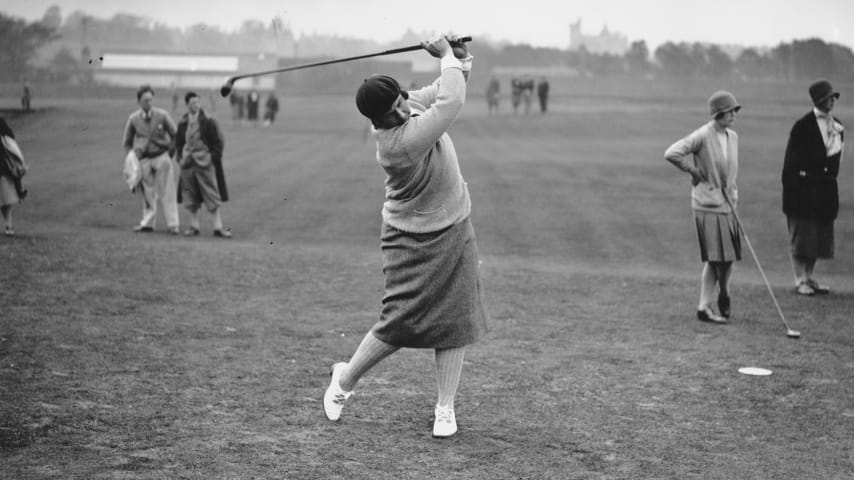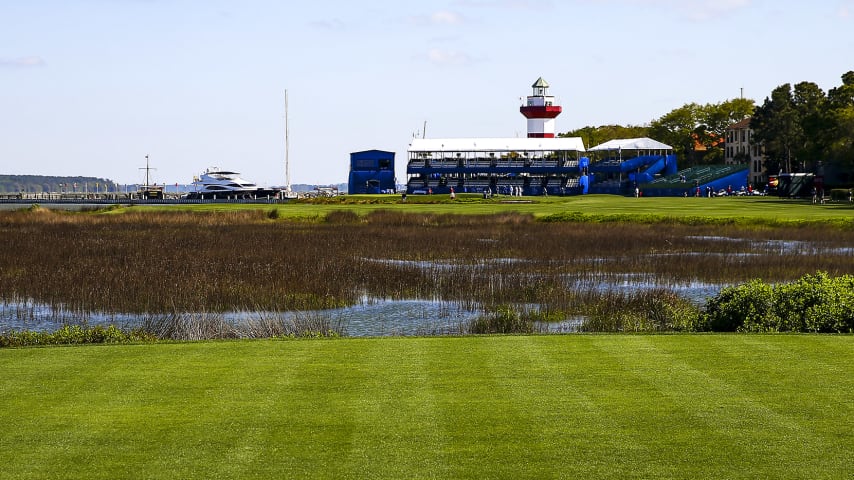The amazing life of Marion Hollins
9 Min Read

American amateur golfer Marion Hollins (1892 - 1944) drives off during the 2nd day of the Ladies Open Golf Championship at St Andrews, Scotland, 15th May 1929. (Photo by Puttnam/Topical Press Agency/Hulton Archive/Getty Images)
A great champion on many fronts, she’s now headed to the World Golf Hall of Fame
Written by Jim McCabe
A great champion on many fronts, she’s now headed to the World Golf Hall of Fame
It’s likely nary a living soul would know what it meant that Marion Hollins was considered a masterful competitor in gymkhana equestrian races or appreciate how flawlessly she could handle a four-in-hand knot while wearing a corset and Edwardian hat or comprehend her national women’s amateur championship despite scores in the 90s.
Which is part of the problem with being in a world that goes so frightfully fast; you’re not afforded the opportunity to study and fathom what happened behind us.
That, of course, is no fault of Hollins, who remains a fascinating study in character and achievement even now, three-quarters of a century since her death. She was of another era, one that included the horse and buggy, so, yes, feeling a connection to Hollins is virtually impossible. But while we are so miserable at appreciating what came before us, savor this majesty about Hollins – she had an uncanny vision for the brilliance ahead of her.
Before our world was sent reeling and forced into isolation to fight the coronavirus pandemic, there was the sweet smell of spring that came floating in with the early days of March. For many, those are days to rekindle a love of golf and for a small, but passionate corner of the golf world that cherishes the memory of Hollins, there was a brilliant symmetry to how March 3 and March 8 arrived in short proximity.
The former was the day finalists were announced for the World Golf Hall of Fame Class of 2021. The latter is designated annually as International Women’s Day, billed as a focal point in the movement for women’s rights.
On both fronts, Hollins’ name generated conversation, and now she becomes the second member scheduled for induction, the news being announced Friday by the World Golf Hall of Fame after she received a favorable vote by the 20-member Selection Committee.Tiger Woods, arguably the most heralded golfer ever, was previously announced and was an easy selection, but just as special was the induction of Hollins as a contributor. While far less heralded a golfer, it can be argued that Hollins authored as compelling and rich a life in the game as any member before her.
Which is where the tie-in to International Women’s Day comes in, because Hollins blazed a trail against longer odds and far more societal biases.
It was nearly 100 years ago – Jan. 20, 1922, to be exact – when a headline in the Philadelphia Inquirer appeared on Page 20: “Plan Golf Club For Women Only.”
Mind you, the 19th amendment allowing women the right to vote had been passed just a few years earlier, if that gives you a sense of the landscape that shaped this nation.
Yet, a women’s group in the New York area was lobbying for a change. “It has long been the custom on golf courses throughout the country for women golfers to give men players full sway and right of way on Saturdays, Sundays and holidays,” the story reported.
Notable was the chairman of the committee who was in front of the movement – Hollins. Just three months earlier, Hollins had defeated Alexa Stirling to win the U.S. Women’s Amateur at Hollywood Golf Club in Deal, New Jersey, and here she was, fronting a cause that transcended the game.
Passionate about the fight, Hollins had a bigger prize in mind than simply getting clubs to relax their rules. She had visions of a club on Long Island being strictly for women golfers and tennis players. Fred Perry, writing in the Philadelphia Inquirer, marveled at the character that was at the root of Hollins’ cause.
“She would rather be right than champion,” he wrote. “Right in the matter of form and style.”
That form and style was central to Hollins’ life, too short that it may have been. She was just 51 years old when she died of cancer on Aug. 27, 1944, but oh, the substantial impacts Hollins made in such a relatively brief life were riveting.
That golf club, for instance, became a reality. The Women’s National Golf and Tennis Club opened in the 1920s, Hollins’ vision carried through by her hand-picked choices to design it: Devereux Emmet and Seth Raynor as a consultant. The project ignited a fire within Hollins and on Jan. 27, 1922, the New York Daily News reported that “Miss Marion Hollins, national golf champion, is on the broad Atlantic today bound for England to study golf architecture.”
She was 29 years old and had already scripted a most marvelous life. The national amateur championship in 1921 had come eight years after Hollins, at 20, had lost to Gladys Ravenscroft in the finals. In between, she managed to win a few women’s titles in the Met Section and become the center of much publicity for her all-around athletic ability.
“America’s Leading Out-of-Doors Girl” exclaimed a full-page story in the Chicago Tribune in 1914 and the copy gushed accordingly in the aftermath of the news that Hollins had been declared a plus-one handicap:
“Marion Hollins is in a class by herself in everything. She rides (equestrian) as well as she golfs. She’s the best woman driver in the east (maneuvering horse-drawn carriages along Fifth Avenue). She’s the star of the Long Island polo team. She swims like a reincarnated mermaid. She plays tennis like a whirlwind. I’d trust myself with her in motor climbing the Jungfrau if she took it into her head to drive to the top.”
Oh, and there was this thousand-pound cherry on top: Hollins was an heiress to millions of dollars, the only daughter and youngest of five children born to H.B. Hollins, a Wall Street brokerage tycoon, and his wife, Evelina Meserole Knapp Hollins, whose father, William Kumbel Knapp is captured for eternity as one of the subjects in the painting, “The Knapp Children,” by Samuel Lovett Waldo and William Jewell, that hangs in The Metropolitan Museum of Art on 5th Avenue in New York City.
Yes, we’re talking high society during in the Gatsby Era or the Gilded Age, take your pick. The Hollins family was related by blood to the Vanderbilts, and H.B. was best friends with J.P. Morgan and there was great comfort on that 600-acre estate in East Islip on Long Island called Meadow Farm. But while blanketed in all that excess, Marion Hollins was as advertised; she was saturated in “form and style.”
Her push to build The Women’s National Golf and Tennis Club validated her mission, but the study of architecture in the U.K. was taken seriously, too. What’s more, Hollins put it to great use when she returned and settled in the area that she would embrace as her new home – the Monterey Peninsula area in California.
It was there, starting in the late 1920s that Hollins forged the final chapters of her incredible life – the visionary behind iconic Cypress Point and Pasatiempo; the impetus to introducing Dr. Alister MacKenzie to Bobby Jones, which directly led to Augusta National; champion golfer at Pebble Beach; U.S. captain for the first Curtis Cup in 1932 – that make her a worthy World Golf Hall of Fame inductee, especially when you consider her push years earlier for women’s rights, long before it became vogue.
With her father having gone bankrupt, Hollins proved she didn’t need to be an heiress. She opened a real estate company in Santa Cruz, California, and began combining her true loves – golf, property, vision, and business.
In MacKenzie, who had designed Meadow Club in Fairfax, 40 miles north of San Francisco, Hollins had befriended the perfect set of eyes and mind to develop a golf course that would be called the Cypress Point Club on Monterey Peninsula. Wrote Grantland Rice: “And at Cypress Point, Del Monte, Miss Marion Hollins (and her group) is planning one of the most spectacular links in the world, with Dr. MacKenzie for the architect. With the Pacific Ocean, the vast white sand dunes, and the cypress groves, there are possibilities here no other course can quite equal.”
Opened in August 1928, Cypress Point has lived up to Rice’s billing and it surely proved Hollins had impeccable golf and business savvy. But she wasn’t done. She had fallen in love with hundreds of acres in Santa Cruz, 48 miles north of Pebble Beach, as you meandered around Monterey Bay. There, she presented MacKenzie with his next opportunity and when Pasatiempo opened on Sept. 8, 1929, Hollins’ star power was confirmed – none other than Bobby Jones agreed to be in her foursome to christen the new course.
Let the record show that Jones, who shot 75, and Hollins were beaten by Cyril Tolley, two-time British Amateur champion, and Glenna Collett, six-time U.S. Women’s Amateur champ, but you could use some literal license and suggest golf was truly the winner because what developed out of the Jones and Hollins teamwork went far beyond the lost game on this day.
The late Dave Anderson, a Pulitzer Prize-winning sports columnist for The New York Times, writing 17 years ago, quoted Sidney L. Matthew, the Jones historian, to put an exclamation point on the Jones-Hollins friendship. “If the women members’ issue (which came to the forefront at Augusta National in 2003) had been raised (back in the 1930s), I think it’s fair to say that Bob would have invited his friends Marion (Hollins) and Alexa (Stirling) to be members.”
Jones thought so much of Cypress Point, which he had also played in 1929, and his two rounds at Pasatiempo that it cemented his choice of MacKenzie to design Augusta National. But the Hollins connection wasn’t done, Anderson wrote. He cited Geoff Shackelford’s book, “Alister MacKenzie’s Cypress Point Club,” and a quote from MacKenzie on Hollins: “She has been associated with me in three golf courses and not only are her own ideas valuable, but she is thoroughly conversant in regard to the character of the work I like.”
Then Shackleford included the quote that has cemented Hollins’ stature in the minds of her many supporters: “I do not know of any man who has sounder ideas,” MacKenzie wrote in a letter to Jones, insisting that Hollins do the on-site inspection at Augusta National in lieu of him.
That MacKenzie died in 1934 and never watched the Masters be competed on his golf course has always been a bittersweet entry to his legacy.
That Hollins – who restored her financial fortune with a $2.5 million windfall from an investment in a speculative oil deal in 1930, only to pretty much spend all of that on her beloved Pasatiempo – died long before her legend behind Cypress Point, Pasatiempo and Augusta National was given proper credit has always been a disappointing omission.
Maybe that will be righted forever with her induction into the World Golf Hall of Fame, an entrance that should be saluted by those who love their champions to have “form and style,” and that most admirable of all human traits, a social conscience.












